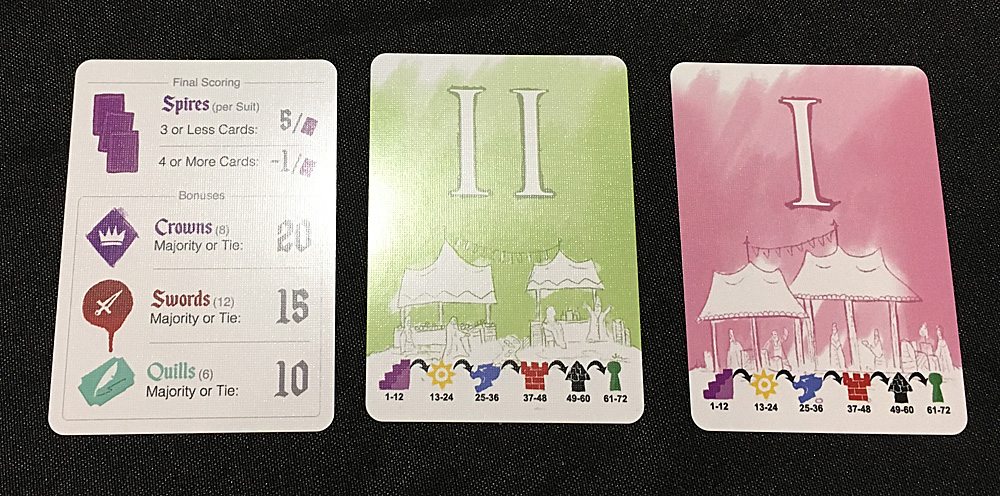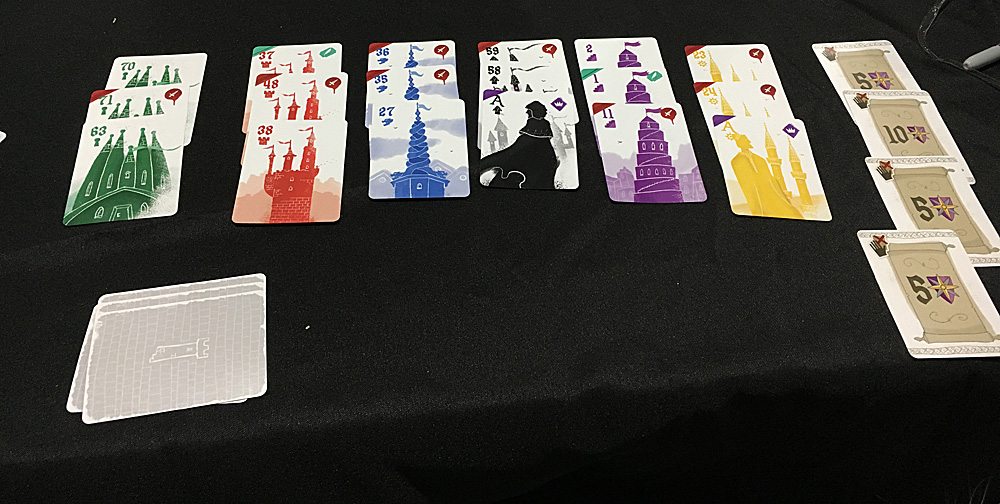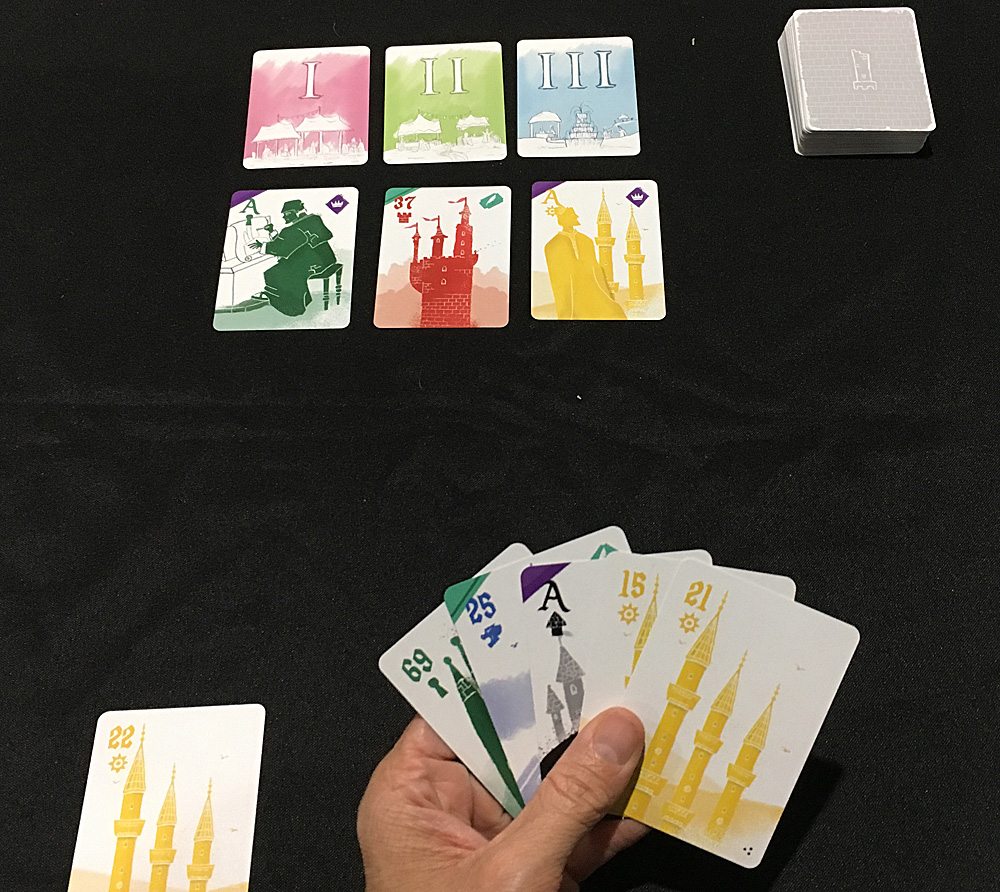 Spires is a new strategic card game for one to four players from Nevermore Games, designed by T.C. Petty III with art by Bryan Fischer.
Spires is a new strategic card game for one to four players from Nevermore Games, designed by T.C. Petty III with art by Bryan Fischer.
New to Kickstarter? Check out our crowdfunding primer. Note I received a prototype of the game so components in photos do not match the final game quality.
Nevermore Games previously published Dark Dealings, a game I love and previously covered as well. And like Dark Dealings, Spires is a competitive multiplayer game that also has a solo mode. Spires will be Nevermore Games’ fourth Kickstarter game if successful, so you know they know what they are doing!
Overview
In Spires, each player is a builder, tasked with building towers for the royal family. The goal is to score victory points by building a tower of each type without building them too high (more than three cards), as building towers higher than the royal palace displeases the royal family and counts against you. Tower cards are gained from the markets by competing with your opponents although sometimes losing a market competition is also a good strategy!
Contents
- 108 cards–Spires, Architects, Scrolls, Markets, and Player Market cards
- Instruction book (PDF draft of the rules)
- The Deluxe level pledge adds a seven card expansion pack of more special cards
- Stretch goals will unlock more cards and upgraded components

Setup is quick and easy, but varies slightly depending on the number of players.
I’ll cover solo play separately below. For two players, Market I and II are placed in the center of play, and all cards marked with three or four dots are removed from the Spire deck. For three players, Market III is also placed in the center and only cards marked with four are removed. For four players, all three Markets are used as are all Spire cards.
Next, each player chooses a color and takes their player cards–a set of Market voting cards that correspond to those in play along with a quick reference card for victory point scoring. A first player is randomly determined and given the first player marker.
The Spires deck is shuffled, and then one card is dealt face up below each Market, five cards are dealt to each player face down for their hand, and, finally, one card is dealt face up to each player onto their tableau (the area in front of them where they will build their towers) to start their first tower.
Gameplay
A round is split into four phases:
- Plan
- Compete
- Refill Markets
- Draw
In the Plan phase, each player secretly decides which Market they want to compete in and places it facedown in front of them. Once each player has selected, play moves to the Compete phase.
In the Compete phase, players start by revealing their voting card. If a player is the only one to choose a particular Market, there is no competition for that player. They take the card from the Market and immediately add it to their tableau. A player who does not get to compete, does not participate in the Draw phase.
If more than one player has chosen the same Market, a competition ensues. Each player competing for a Market secretly selects a card from their hand to compete with. All players reveal their cards at the same time. The winner takes not only the card from the Market but all cards used in the competition and ALL cards must be added to their tableau. Because a player might get more cards than they bargained for, or wanted, you can start to see where strategies around intentionally losing a competition come in to play.
So how are competitions resolved? The highest card played matching the suit of the card in the Market wins. If no cards of the same suit are played or if the only card in the market has no suit (like a scroll card), the highest card played wins. It is important to note that the value on Spires cards is only relevant for resolving competitions and has no impact on scoring at the end of the game.
Cards played on the tableau always go on the spire of the matching suit. If a player does not yet have a Spire of a particular suit, a new Spire is started. A player will have six Spires at most (one from each suit). Spires are layed out vertically allowing the quite, card number, and special symbols to be visible.
Once all competitions are resolved and cards played to tableaux, the Refill phase occurs. Any Markets are refilled from the Spires deck in order from I to III.
Finally, any players who competed, draw from the Spires deck back up to five cards. Drawing occurs clockwise starting from the player to the left of the first player. If during the Draw phase, a player draws a scroll card, the scroll card is added to any Market of the player’s choice, potentially sweetening or souring the pot for a given Market. The player then draws again to replace the card in their hand.
The End of Game is triggered when the Spires deck runs out and all cards have been won from all of the Markets. When this happens, all players must add three cards from their hand to their tableau before scoring takes place.

Variations
There are rules for a variation on the way competitions are resolved using the suites of the Spires card that we didn’t try, but it does definitely add a whole different strategy to competitions.

Gameplay begins by selecting a Market and a card to compete with. The top card is drawn from the Spires deck as the competitor. Competition is resolved exactly as in the regular game. A key different here is that all remaining Market cards are discarded after competition is resolved. This means that there is only ever a single chance to get a given card. New cards are dealt to each Market, the player draws a new card and repeats. This continues until all Spires cards are used up. Scoring works exactly as in the standard game. The final score is compared to the chart in the back of the rule book to find the outcome of the game. Spoiler alert: The King is never happy. I learned the hard way that strategically losing is even more critical in solo play as I finished my first game with 11 points.
The Verdict
Spires is an absolute blast, and, once you pick up the rules, plays very quickly. Because there is so much variety in strategy and card suites, everybody can develop their own unique playing styles and provides a ton of replayability to the game. I have a hard time getting my wife to play games with me as she is a more casual gamer than I. However, not only did she really enjoy playing Spires with me, after watching my play solo a few times, she proclaimed that she could “totally play this by myself.” It’s very important to note that the only tabletop game she will ever play solo is literally solitaire.
For $15 (or $20 for the deluxe), you really can’t beat the value on this game. It’s easily portable, easy enough for a wide range of ages to play, quick enough for a palate cleanser on game night, and has a solo mode that is really fun to play. Back the Kickstarter now!




